Preparing a garden for planting winter garlic in the fall: how to fertilize and what to make
A good harvest of garlic directly depends not only on the quality of the planting material, but also on a properly prepared garden bed. After all, even good cloves can hardly become large heads of garlic if the soil is heavy and poor, and the place is shady and moist.
Next, you will learn how to prepare the garden and soil. for planting winter garlic in autumnwhat kind of fertilizer to add to it.
By the way! A bed under planting winter onions prepares in the same way.
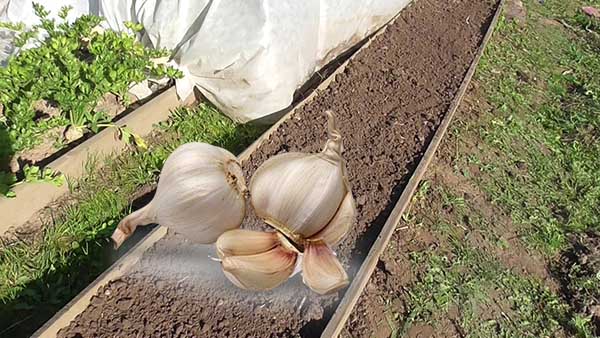
Content
How to properly prepare a bed for planting winter garlic
Garlic bed preparation plan:
- choosing a suitable place on the site;
- cleaning the beds from weeds;
- introduction of loosening agents and soil improvers (fertilizers - mineral and organic), including deoxidizing the soil (if your soil is acidic);
- digging or loosening;
- leveling (leveling the surface);
- watering (for better soil shrinkage) and soil treatment (disinfection with fungicides, colonization with beneficial bacteria).
- timely (2-4 weeks after the preparation of the garden and 2-4 weeks before the first frost) and correct seating of teeth (how and with what to process, to what depth and at what distance).
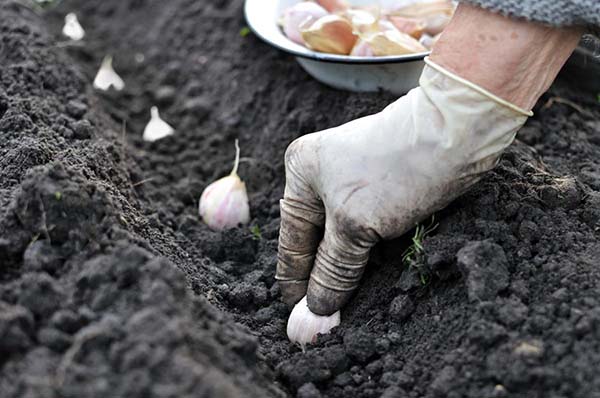
Important! Preparation of beds for winter garlic begins with choosing a good place on the site, and this must be done in advance.
When to cook the garden
The preparation of the garden (by applying fertilizers to it), where winter garlic will be planted, begins to be engaged about a month before the start of planting work (at least a couple of weeks).
Example! If you usually plant garlic in early October, then it is advisable to prepare the garden in the first half of September (1-2 decades).
Why?
The fact is that a garden bed for winter garlic (and other crops) is made in advance so that the soil has time to settle after digging (loosening).
Note! If you do not allow time for shrinkage and plant the garlic immediately after preparing the garden, then the cloves will simply be pulled into the ground (to an excessive depth), because of which in the spring they will germinate longer and, as a result, will be smaller.
The soil for cultivation should be loose, but it should be planted in the already settled and compacted, and not loosened and airy.
And to speed up the shrinkage of the soil, you can spill the garden with water.
Choosing a place for a garden on the site
You need to choose a place for a bed for garlic that is well lit, which receives a lot of sunlight.
As for the location in the garden, ideally the garden bed should be located in a sunny location, from north to south.
As for the size of the bed, as a rule, the bed is made 80-100 cm wide, and the length is at your discretion (about 5 meters), and 20-25 cm high.
You should not plant garlic in shaded areas of the garden (next to spreading trees), and also make beds next to tall vegetables (for example, tomatoes, cucumbers on trellises).
Advice! It is very good to plant garlic next to garden strawberries (strawberries).
A place in the lowland where moisture (melt water) accumulates is not suitable for a garlic bed, otherwise, after the snow melts, the bed will simply flood, because of which the cloves will rot (vyryut).
It would be more correct to plant on a hill or even better to do a high and warm bed.
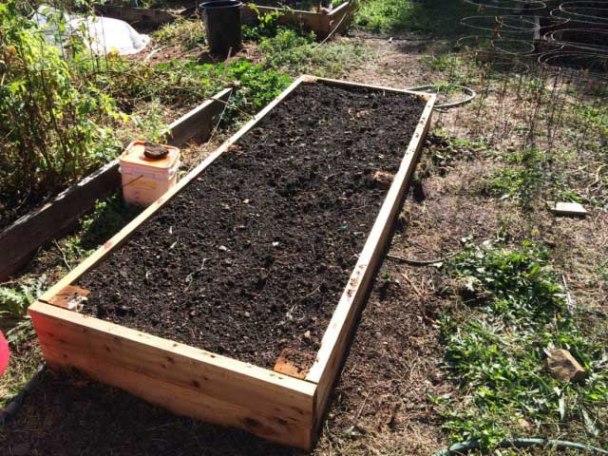
Best predecessors: crop rotation rules
Naturally, if you want to get a rich harvest of winter garlic, then planting it, like any other vegetables, is recommended according to the rules of crop rotation and crop rotation.
At the very least, it is undesirable to plant garlic in the same garden where it has already grown this season, although this is generally allowed.
By the way! About, after what crops is it better to plant winter garlic in autumn, read in this article.
What to add to the soil, what fertilizers
As you know, garlic loves loose and fertile soil, so you should carefully fill the bed with the necessary fertilizers, and also apply baking powder (if you have a heavy clay soil).
So, having chosen the optimal place for placing the beds on the site, you need to add baking powder and fertilizers to improve the structure (if necessary) and soil fertility, and then dig up the soil to a depth of about 20-25 cm (shovel bayonet)while removing all weeds and other debris.
If you not a supporter of deep diggingthen of course you can spend shallow loosening Fokin's flat cutter (5-8 cm).
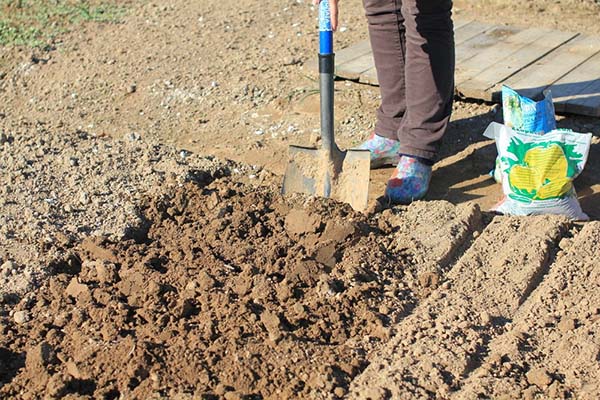
As we have already found out, garlic grows well on light soil, perfectly permeable to air and water (they also say “air and moisture permeable"), And most importantly, having neutral acidity (pH 6-7).
If your soil is too acidic (pH below 5.5), then add more for digging. wood ash (it is also an excellent potash fertilizer) or dolomite flour.
With regard to soil structure:
- If you have soil quite sandy, then it is worth considering that to get large heads you will need a little more care: more frequent watering and fertilization.
- If the soil excessively clayey, then you can make it looser by introducing peat, humus and sand.
Note! Garlic, like other root crops, will not grow and develop normally in heavy clay soil, only in light and loose (also called "fluffy").
So, let's get to the most important thing! Namely, how to improve the fertility of your soil, what kind of organic and / or mineral fertilizers.
Advice! It will be just great if you mix organic with mineral water.
If you are a supporter organic farming, then the following fertilizers should be applied for digging (in the calculation for 1 sq. meter garden depending on the initial fertility of your soil):
- humus (rotted manure) or compost (half a bucket-bucket);
Only do not apply fresh manure!
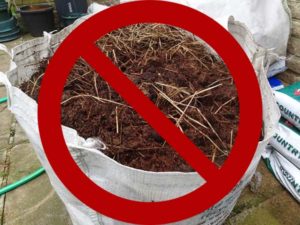
- wood ash (1-2 cups or 100-200 grams).
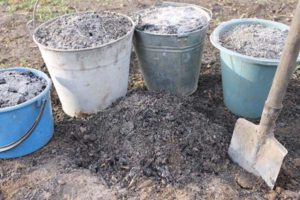
By the way! Ash can be poured into holes or grooves right before planting.
If you allow the use of mineral fertilizers, then make the following phosphoric and potash (again, per square meter of beds, depending on fertility):
- superphosphate (30-40 grams);
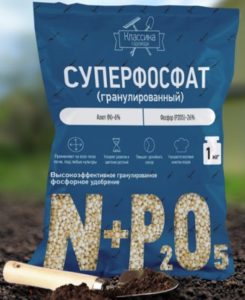
- potassium sulfate (potassium sulfate) or any other potassium fertilizer, for example, potassium magnesium (20-30 grams).
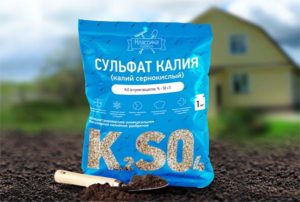
Important! Not recommended add to the soil for autumn planting of garlic nitrogen fertilizers (urea, ammonium nitrate)! They are brought in in the spring, during the first feeding of the garlic.
After digging (loosening) and applying the necessary fertilizers to the soil (they need to be distributed as evenly as possible over the entire area of the garden), the bed is well leveled and left until autumn planting.
Garden bed processing
Some gardeners advise to additionally protect (in order to prevent fungal diseases) and disinfect the soil by spilling it with a 1% solution copper sulfate.
Better yet, use biological products, for example, the same Fitosporin.
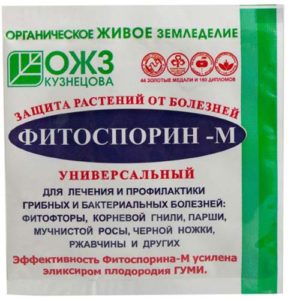
You can also spill the garden Baikal or Radiance (1 and 3).
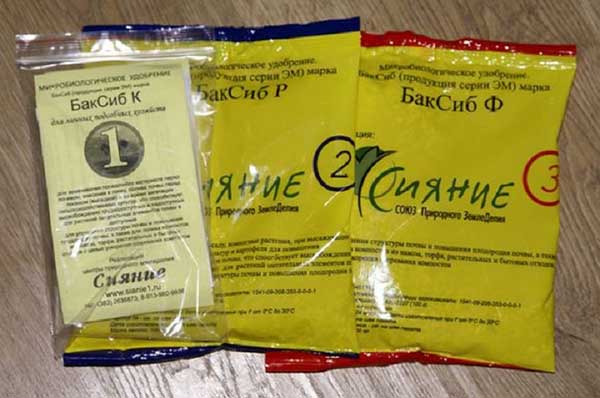
And then close it with a film (cardboard), securing it with boards or bricks.
The main thing is that it should be at least +10 degrees and humid: then the biological products will work.
Do not skimp on fertilizers and organics if you want to get large heads. After all, if you plant garlic in poor and / or depleted soil by the previous crop, then you will not be able to count on a decent harvest.
Advice! And already about when and how to plant winter garlic in autumn, read in this detailed article.
Video: preparing a garden for garlic (autumn planting)

